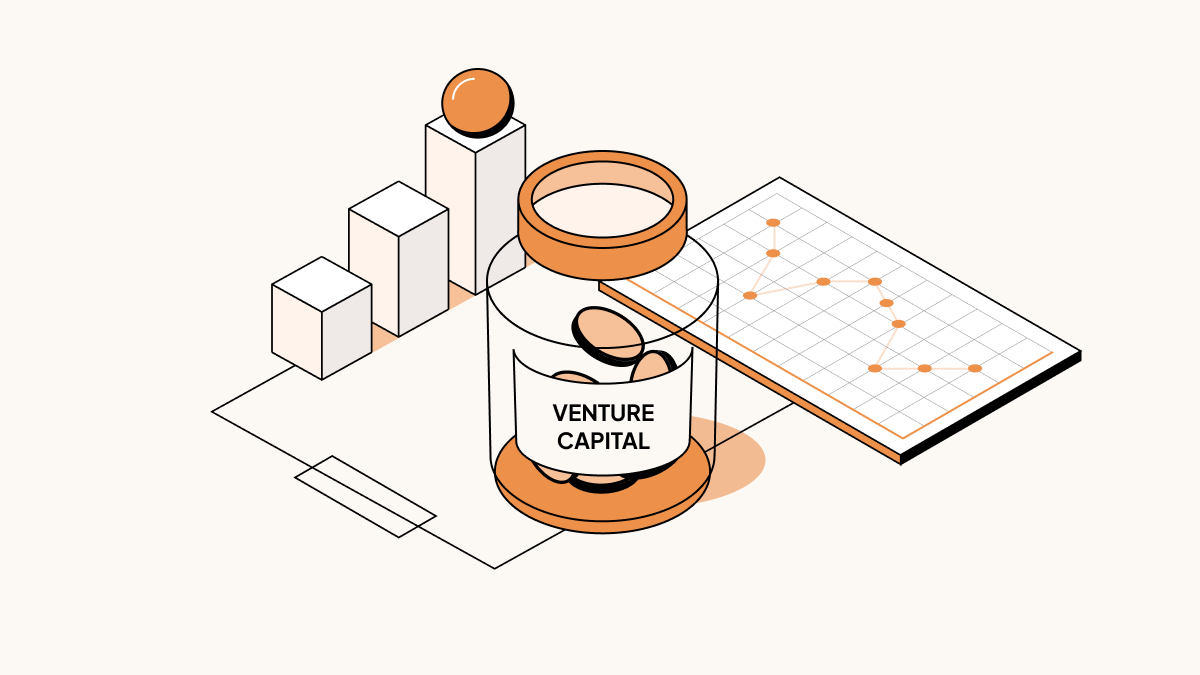If you’re considering starting and raising your own venture capital fund, you might already work at a venture capital firm or be an angel investor. Or maybe you work at a tech company, or a nonprofit organization completely outside the startup network. Regardless of where you’re starting, it’s crucial to understand the ecosystem you’re stepping into.
What is venture capital?
Venture capital (VC) is an investment strategy in which investors provide early-stage private companies or startups with cash in exchange for an ownership piece of the companies. The investors’ hope is that the startups will become more valuable over time so that when there is a liquidity event or other opportunity to sell off equity in the company, the investors might make a profitable return on their investment.
To pursue these strategies, the venture capital investors pool their own capital with outside money from others to invest in startups. The VCs who manage these pools of capital are also known as the general partners or GPs, and the outside investors are also known as limited partners or LPs. The VCs set up asset management firms to manage all of the funds they launch.
VC firm vs. VC fund
Venture capital firms are different from venture capital funds.
The VC firm is the business that oversees the investment strategies of the VCs. It’s the entity you’re thinking of when you hear the brand name of a VC. It is the management company that rents office space, employs investment analysts, and subscribes to financial publications. Successful venture firms often operate several VC funds at one time—Fund I, Fund II, and so on.
The VC fund is the legal entity that pools money to invest in assets like startups and pursues its own particular investment strategy. The fund then owns those assets until it sells them.
→ Learn more about VC fund structures
How to start a venture capital firm
In the steps below, we’ll outline the steps to setting up a new VC firm before raising your first fund.
Step one: Know your track record
Your track record is your past performance as an investor that details the types of investments you’ve made, why you made them, and what kinds of returns you’ve been able to secure. Prospective LPs have many firms and funds to choose from. To gauge your potential for success, they'll consider investment performance metrics like total value paid-in (TVPI), multiple on invested capital (MOIC), and internal rate of return (IRR).
If you’re starting your first firm or fund, you won’t be able to point to previous fund metrics. To prove to LPs that you have what it takes to be successful, first-time fund managers can establish a track record in a few different ways:
-
Angel investing: Making a series of angel investments can allow you to assemble a portfolio that resembles a personal venture fund. Angel investments can be any size, but usually they’re under $100K.
-
SPVs: Aspiring fund managers can also use special-purpose vehicles (SPV) to give their network access to deals. SPVs are entities that can pool money with the sole purpose of investing in a single company.
-
Warehousing investments: Warehoused investments are investments in portfolio companies that a VC makes while fundraising but before the fund entity is legally formed. The investments are reserved as to be transferred to the fund once it is closed.
Step two: Partner up
You can start a VC firm solo, but having someone else who can complement your own skills can be beneficial for your first time. For example, if you have a strong operational background as a former COO, you might want to partner with someone with a background in finance or with technical expertise.
From there, you can figure out the basics, such as how you’ll pay yourselves, where your office will be, what equipment you’ll need, and who you need to hire next.
The founding general partner role
As a fund manager you’ll be both an entrepreneur of your own firm and a fiduciary of outside capital. You’re responsible for attracting the attention of companies and founders, corresponding with LPs, constructing a portfolio, executing deals, and handling fund administration.
That’s why it’s helpful to start with the following (although not an exhaustive list):
-
A compelling investment thesis
-
Good relationships with founders
-
Business or industry expertise
-
A competitive drive to win deals
-
A smart portfolio construction strategy
-
Great networking skills
-
Patience
-
The ability to articulate why your fund is different
-
The willingness to contribute financially
Step three: Determine your VC firm’s structure
Limited partnerships and limited liability companies (LLCs) are used to facilitate relationships between VCs and third-party investors, as well as operate the activities of the VC firm itself.
Limited partnership
Most VC funds are structured as a limited partnership (another type of legal entity), which is made up of at least one GP and at least one limited partner (LP). The GPs and LPs of a limited partnership can be individuals or legal entities.
Limited liability company (LLC)
Most VC firms, or management companies, are structured as an LLC, which provides each member with the benefits of both limited liability and pass-through taxation. This separation by legal entities limits liability to the individual entities, rather than exposing the various types of VC cashflows and other assets to liability from any one of the funds. This means that if one of a firm’s funds gets saddled with liabilities, it generally won’t impact its other funds.
VC firms then form separate LLCs to act as the general partner entities for each venture fund. (Typically, the fund managers themselves are the members of this GP LLC entity.)
While management companies are typically structured as LLCs, the internal organization can vary depending on the VC firm’s operating preferences, like team, overhead, and platform activities. Because the same employees within a management company may perform services for multiple funds, the management company will sit across multiple funds.
Step four: Fundraise and form your fund
To get your first fund up and running, you’ll need access to a pool of money you can use to make investments. Typically, VCs raise a fund by soliciting contributions from outside investors. These third-party investors become limited partners in the fund.
Your fund’s LPs will remain passive, while you as the fund manager will make the day-to-day investment decisions. Limited partners officially become investors in your fund when they sign and submit a limited partnership agreement, a legal contract that outlines the details of their partnership with the fund.
→ Learn more about a fund’s limited partnership agreement (LPA)
Step five: Bring the resources back in
As the GP of the fund, the LLC you created to act as the fund’s general partner has the legal authority to manage the fund’s affairs—which includes the ability to hire service providers. At firms with multiple funds, the VC firm usually acts as the management company for all of its funds. In other words, the fund’s GP hires the VC firm to perform management functions for the fund—like hiring and paying investment staff, securing office space and computers, and so on.
This way, the VC firm is still able to share its resources for the benefit of all of the funds it oversees, while shielding itself from liability from all of those funds.
Step six: Operationalize your fund
The last step to starting your venture capital firm is identifying the right service providers who can help support and launch your fund.
This might include:
-
A bank where you can open bank accounts for your fund
-
An audit firm if your fund needs to be audited
-
A tax provider to help prepare tax documents
-
A lawyer to help you modify the LPA and negotiate with LPs
-
A fund administrator to help manage all of the back office needs for your fund
Raising a fund
Even if you’re a seasoned investor, raising a VC fund requires a completely different set of skills than making individual investments or working within an existing VC organization. Many first-time fund managers organize their fund strategies around their personal experience and networks of experience because these connections can offer privileged access to deal flow, talent pools, and industry expertise.
What problem are you trying to solve?
Before you can raise a new fund, you need to clarify the problem you’re trying to solve. Be as specific as possible about your intentions. Once you know the problem you want to solve—say, lack of capital for female founders at the seed stage, a lack of support for early-stage founders in the Midwest, or the development of innovative climate resiliency technologies—you can do some further research and refining.
Consider the following factors before you raise a fund:
-
Your own expertise: What kind of experience and expertise do you have? Is your knowledge, skill set, or network an asset? What tools do you have at your disposal? Where will you need help?
-
Your target demographics: Who are the founders and companies you want to help? What are their struggles and goals? What are their specialties? Where do they live and operate? Who are their target customers? How much capital have they historically raised and when? What kind of LPs will be interested in investing in these founders?
-
The market landscape: Do institutional investors want access to your target demographic? Why or why not? What other companies and venture capital firms are trying to solve the problem you want to solve? Where are they succeeding and falling short?
The answers to these questions will either serve as the foundation to your fund strategy or guide you in another direction.
→ Learn more about how to create a fund strategy
How to recruit LPs to your first fund
Building a convincing fund thesis and conveying it in a professional pitch deck is challenging work. But it’s only half the battle. Finding LPs whose investment interests align with your fund thesis—and persuading them to invest capital in your fund—is your next challenge.
Most venture capital funds raise under regulatory exemptions that prohibit them from advertising or making public solicitations for capital contributions. That means you can only fundraise from your existing personal and professional networks. The number of potential limited partners in your networks may depend on your background, your work experience, and where you live. These will mostly be individual investors (also known as angel investors) who meet the definition of an accredited investor.
As an emerging fund manager, you’ll need to canvas your network, ask for introductions to new LPs who have an interest in your investment areas, and start taking meetings. Start by making a list of people in your networks who may qualify as accredited, and pitch them on your investment thesis.



